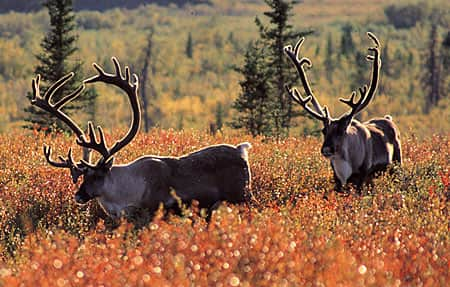Alaska Caribou Numbers Declining, Officials Consider Harvest Restrictions
OutdoorHub Reporters 05.23.14

At its peak in 2003, the Western Arctic Herd (WAH) numbered over 490,000 animals and was a strong contender for the largest caribou herd in North America. Since that point, the herd’s numbers have fallen. The Alaska Department of Fish and Game (DFG) announced on Monday that the herd’s decline appears to be continuing, with recent surveys showing a dramatic 27 percent population drop from 2011.
“Caribou numbers fluctuate naturally,” said DFG biologist Jim Dau. “However, we’ve only had the technology to accurately count caribou herds since about 1970. The current WAH decline is still within the range of change documented for this herd in the past.”
The department estimates that as of July 2013, the herd’s numbers had dropped to 235,000 animals from 325,000 in 2011. Although biologists cannot say for sure what is causing the longtime decline of the herd, it is believed that deep snow and an abundance of predators were responsible for the high mortality rates in 2011-2012. The survival rate of calves born in recent years was also low.
“I’m often asked, ‘Why the decline?’ In truth, we don’t have data to completely answer that question. But it appears that summer and winter weather combined with predators have affected survival during recent years,” Dau said. “Disease does not appear to be a factor, caribou have generally been in good body condition throughout this decline, and we don’t think harvests initiated it. But, if harvests remain stable, they will increasingly affect the population trend as herd size goes down.”
There are approximately 750,000 wild caribou in the state of Alaska, including some herds that are shared with nearby Yukon. The Western Arctic Herd contains by far the largest number of caribou, while the Porcupine Caribou Herd is believed to contain 169,000 animals. The smaller Fortymile and Teshekpuk herds contain over 50,000 each. At one time the Western Arctic Herd contested eastern Canada’s caribou population for the title of the world’s largest caribou herd. Now some fear that it will meet the same fate as a former holder of that title, the George River Caribou Herd, which went from being 800,000 strong in the 1980s to less than 74,000 in 2010.
Experts say that migratory caribou populations do cycle naturally, but usually over a span of 50 to 70 years. Last year wildlife officials in Canada initiated an immediate and total ban on hunting for the George River herd in the hopes of stemming the decline.
“Our first priority is conservation of these animals, and that is why we are imposing a total ban on this herd,” Environment and Conservation minister Tom Hedderson said in a 2013 press release. “George River caribou have shown a continued steep decline in the latest survey results, and a continued harvest is simply not sustainable at this point in time. The goal of today’s decision is central to all people of Labrador to help ensure that the George River caribou will be here for future generations. Given the biological information that we have, we must do our part and work together to ensure the herd’s existence.”
Likewise, Alaska officials are also considering restricting harvest restrictions. If the agency does decide to limit hunting for the Western Arctic Herd, it would be the first time that the department has done so in over 30 years. The herd is also immensely important to the communities that live within its 140,000 square-mile range, not only as part of their heritage but also as a food source. Alaskan hunters harvest about 22,000 caribou every year for food.

